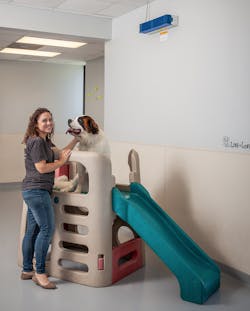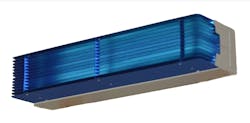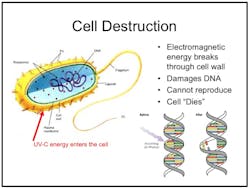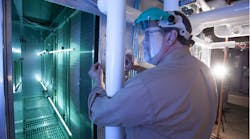Latest from IAQ & Ventilation
New HVACR Products: December 2024
New HVACR Products: September 2024
New HVACR Products: August 2024
S&P USA Names New National Director of Sales
New HVACR Products: July 2024
Modern Parallels to July 1929, with Rob McManamy
Steril-Aire Celebrates Three Decades of UVC Innovation
Battling Climate Inside the O.R.
Selecting Ceiling Radiation Dampers
By DAN JONES, UV Resources, Santa Clarita CA
“We do everything possible to safeguard the health and safety of our guests,” says pet daycare owner Josh Donahue, who recently added hospital-grade, infection-control fixtures throughout his family’s 5,000-sq-ft facility in suburban Wake Forest NC.
“If animals get sick under our watch, no one will care a lick about our outstanding care and years of industry expertise,” says Josh who, together with his wife Mandy, opened Audrey’s Barkyard in November 2017. “A sick pet means we’ve broken our customer’s bond-of-trust and lost any hope of future referrals that drive 90 percent of our business.”
So, when they learned the business could affordably incorporate protection against airborne pathogens, the couple jumped at the chance to offer this extra safeguard—both for the animals and their community reputation. Mandy explains that in some sense, pet care is about providing owners with the peace of mind that their animal will be treated like family.
“We already had a pretty extensive nightly sterilization routine, where we apply a hospital grade disinfectant on kennels, floors, yard and surfaces,” she recalls of their premier pet boarding, daycare and grooming facility. “But so many diseases are spread through the air, Josh and I quickly realized there was a gap in our infection-control strategy — we needed a means of killing the bacteria in the air.”
Germicidal Treatment
The couple turned to Jess Kota with Greensboro, NC-based Clark Air Systems for recommendations on how to supplement the pet care’s existing disinfection procedures. A specialist in ultraviolet air and surface treatment, Kota recommended the use of ultraviolet germicidal irradiation (UVGI or UV-C) technology that uses short-wavelength ultraviolet energy—similar to sun rays—to kill or inactivate airborne and surface-bound microbes.
Kota suggested two separate applications of UV-C to ensure the greatest practical control of microbes and airborne microorganisms: 1) upper-room UV-C disinfection units in pet common areas and the building lobby, and 2) UV-C fixtures in the HVAC supply air units to clean airstreams and cooling coils.
While ultraviolet technology (or electromagnetic energy in the 254-nm UV-C band) has been used by hospitals since the 1930s to control airborne infectious diseases, its application in animal boarding and daycare facilities is rare, according to Mandy.
After examining the pet care facility and routine activities, Kota specified six wall-mounted upper-room UV-C fixtures that reduce airborne microorganisms near a room’s ceiling. The high-output GLO™ UV fixtures use baffles to direct the germicidal wavelength upward and outward to create an intense zone of UV-C irradiation, while allowing no harmful UV irradiation into the lower occupied space. Convection or mechanical air currents lift airborne infectious agents into the upper air, where they are exposed to the UV-C wavelength, which breaks the bacteria or virus DNA chain rendering them incapable of reproducing.
In addition to treating the building’s upper-room air, Kota also recommended adding germicidal fixtures to its HVAC system, where infectious agents can multiply year-round and allow viral agents to remain viable for much longer periods. Kota addressed these areas by installing two, Hornet™ UV-C fixtures in each of the pet care facility’s three HVAC air handlers to destroy microbes in supply air and on cooling coils, drain and duct surfaces.
Both units, available from UV Resources, are designed to efficiently inactivate airborne-transmitted pathogens, as well as destroy surface microbes and degrade organic materials that impede HVAC system efficiency. In addition to inactivating pathogens on HVAC surfaces, installing the Hornet in an air handler, Kota notes, can kill up to 35 percent of infectious agents moving through the air.
Reducing Disease Transmission
Like most facilities, Audrey’s Barkyard requires clients to be up-to-date with pet vaccinations, including those covering rabies, distemper and bordetella (commonly called “kennel cough”). While vaccines can lessen the severity or prevent certain diseases altogether, Josh acknowledges the ease which airborne pathogens can be spread from animal to animal — a bit like how the common cold is spread among children in elementary schools.
“Animals can acquire some upper respiratory infections by simply passing one another on the sidewalk, yet symptoms may not appear up to five days,” continues Mandy. “That means animals can spread a disease before anyone knows they are contagious and, more importantly, before anyone can take preventative precautions.”
Staff at Audrey’s Barkyard were already using a medical-grade, broad-spectrum disinfectant on all animal equipment and facility surfaces (counters, walls, fixtures and floors). However, for bacterial strains that are spread via air, the UV-C technology would limit the ability for germs to infect multiple animals.
Josh points to a recent case in which a dog developed kennel cough after returning home from four days of boarding. Despite close contact with 40-50 other dogs, there were no reports of other dogs getting sick after interacting with the highly contagious pet. This, he says, is the significant value of the germicidal technology: the ability to limit the spread of contagious diseases and bacteria.
Containing Outbreaks
During peak enrollment periods at the facility—typically during holidays and school vacations— up to 80 animals can be in close contact, providing an opportunity for cross contamination.
“Because of the extended incubation period for some of these diseases, facility operators may not even know about a problem until a customer calls to alert us to a potential problem,” states Mandy. “Without a layered infection control strategy, large-scale outbreaks can quickly spread and take weeks before the contagion is completely eliminated.”
In addition to safeguarding animals, the added infection control procedures also offer pet owners confidence in their choice to entrust their pet to Audrey’s Barkyard. Like the facility’s four webcams where parents can see and check in on their pets, the additional infection-control measures are another competitive advantage, Josh believes. In the age of YELP and Facebook, poor reviews and word-of-mouth can make or break a local business, especially in a close-knit community where residents routinely look to social media for business endorsements.
“If your pet becomes sick at a new center, not only will you find another provider, but your impression of that facility will forever be negative,” he asserts. “Why wouldn’t a business invest in keeping customer pets safe and do everything possible to demonstrate its care and compassion?”
BACKGROUND: WHAT IS UV-C ENERGY?
UV light comprises a segment of the electromagnetic spectrum between 400 and 100 nm, corresponding to photon energies from 3 to 124 eV. The UV segment has four sections, labeled: UV-A (400 to 315 nm); UV-B (315 to 280 nm); very high energy and destructive UV-C (280 to 200 nm); and vacuum UV.
Most of us are familiar with the harmful effects of UV energy transmitted by sunlight in the UV-A and UV-B wavelengths, giving rise to UV “sunburn” inhibitors, or blocking agents, which are found in glasses and lotions. We are also familiar with products engineered to withstand the effects of UV radiation, such as plastics, paints, and rubbers. However, unlike the UV-A and UV-B wavelengths, the UV-C band has more than twice the electron volt energy (eV) as UV-A, and it is well absorbed (not reflected) by organic substances, adding to its destructiveness.
UV Energy’s Killing Power
UV-C’s germicidal or germ-killing effects are well proven. The UV-C wavelength owes these destructive effects to the biocidal features of ionizing radiation; or, more simply, UV-C does far more damage to molecules in biological systems than temperature alone can. Sunburn, compared to the sensation of warmth, is one example of that damage. Sunburn is caused by sunlight striking and killing living cells in the epidermis; the resulting redness from a sunburn reflects the increased capillary action and blood flow that allow white blood cells to remove the dead cells.
It is this ionization function that drives UV-C’s power to alter chemical bonds. The 254 nm wavelength carries enough energy to excite doubly-bonded molecules into a permanent chemical rearrangement, causing lasting damage to DNA, ultimately killing the cell. Even a very brief exposure to UV-C can permanently eliminate microbial replication
HOW TO APPLY GERMICIDAL TECHNOLOGY
There are multiple approaches to using UV-C to ensure the greatest practical control of microbes and airborne microorganisms in communal spaces, including:
Upper-Air Disinfection: The primary objective of upper-air UV-C germicidal fixtures is to interrupt the transmission of airborne infectious diseases in communal spaces (e.g., waiting areas, cafeterias, sports facilities, etc.). Airborne droplets containing infectious agents can remain in room air for 6 minutes and longer. Upper-Air UV-C fixtures can destroy those microbes in a matter of seconds. Kill ratios over 99.9 percent on a first-pass basis have been modeled and, as air is recirculated, concentrations are further reduced by each subsequent pass (“multiple dosing”).
HVAC Surface Cleaning: Surface-cleaning UV-C systems provide 24/7 irradiation of HVAC/R components to destroy bacteria, viruses and mold that settle and proliferate on HVAC coils, air filters, ducts and drain pans. UV-C prevents these areas from becoming microbial reservoirs for pathogen growth that will eventually spread into airstreams. A system installed for surface irradiation, can also provide first-pass kill ratios of airborne pathogens of up to 30 percent, with ancillary benefits of restored cleanliness, heat-exchange efficiency and energy use.
The author is president of UV Resources, which specializes in the education, design and installation of ultraviolet-C (UV-C) equipment for a variety of commercial, healthcare, government and residential HVACR applications.













